Udaipur to Chittorgarh to Bundi Sun 28 Feb – Mon 8 March 2010
Back in Rajasthan we stopped at Abu Road on the way to Mount Abu to eat. Something was obviously afoot as everywhere there were big crowds singing and dancing and huge bonfires roaring away. Then we remembered this was the beginning of the Holi festival which is held on the first of March every year to welcome the spring. These bonfires built on the night before Holi symbolize the destruction of the evil demon Holika. It was a full on party atmosphere and we were to see much more Holi action the next day!
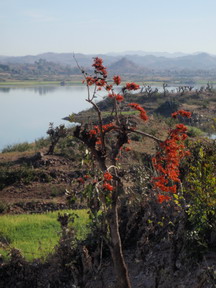

For the moment we headed to a restaurant and had a meal. It seemed shocking after 8 weeks in dry Gujarat to see beer on the menu again so we celebrated by having one - though at 120 rp ($3 Aus) it was more than we usually pay at the bottle shops. We had planned to make it all the way to Udaipur that night but it was getting dark and also we were a bit concerned about being on the roads amongst drunken crowds of Holi revellers so after a few kms we pulled off the highway and followed a sign to the Sai Dam. We followed a twisty road down to the dam buildings where 3 security men were stationed. They were a bit amazed by us but after a bit (they had no English) we managed to get across what we wanted and they agreed that we could stay the night. It was nice and quiet off the main road and we slept really well. The next day we took a wander around and it was a really attractive area - with intermittent flame trees and the hills as a backdrop. The dam was of course pretty low as there have been no good monsoon rains for quite a few years now which is a worry for the farmers.
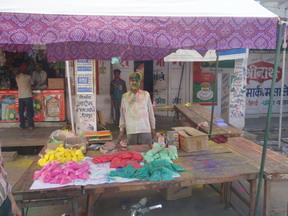

We drove the last 50 odd kms to Bundy through mainly deserted roads due to the Holi festivities. On the way we passed a smoldering brick kiln - very hard work in the intense heat the poor workers there didn't seem to have much time for Holi. As we got to the villages surrounding Udaipur we began to see signs that Holi was in full swing as everyone we passed - all sexes and ages - was multi coloured. Holi - the festival which celebrates the end of winter and welcomes in spring is celebrated by throwing coloured water and gulal (powder) all over each other. If you're in town that day you can either hide in your hotel room or you have to brave it and end up multi- coloured. We chose to do the latter and pulled over to change into our oldest clothes!

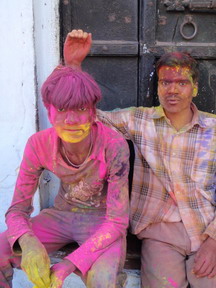
We had decided to visit the Monsoon Palace whilst in Udaipur - perched on the hill top overlooking town we'd looked up at it (and seen it in Octupussy the James Bond movie) but never made it up there on our previous visit. Some nice guys gave us directions there and then asked if they could "play Holi" with us - which was our first colour - very subdued for me just a tikka.
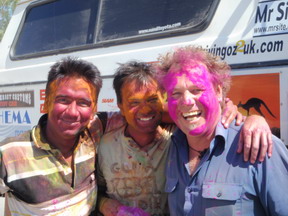

We made it to the palace to find that it (like everything else in Udaipur that day!) was shut. Getting back to town we parked the car and went for a walk. Of course now we were "coloured" we were part of the festivities and as foreigners everyone targeted us so we were soon totally multi- coloured with various layers of powder. Revellers of all ages were getting into it and stalls everywhere were busy selling reinforcement supplies of fresh powder!

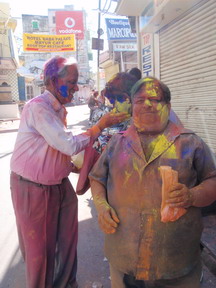
It was good fun but after a while we felt the need to escape the madness and found a fairly up market hotel with a roof top restaurant full of immaculately clean tourists hiding from the madness outside. It was a bit like stepping into another world! We hung there and had lunch before braving the festivities again. Things had died down by now though we still came under attack! There is a lot of drinking and consumption of bhang (a cannabis derivative) amongst the "wild youth" at Holi and we later heard horror stories of drunken assaults and people having been doused with toxic substances. What we saw was all good fun but towards the end there were very large groups of very drunk/stoned young guys which was a bit scary - not a good time to wander around as a girl on your own! As a lot of them are still zooming around town on motorbikes not a great time to be on the roads either - so we decided to stay that night! On the whole though we enjoyed it all - been there done that one - not sure we need to ever do it again!
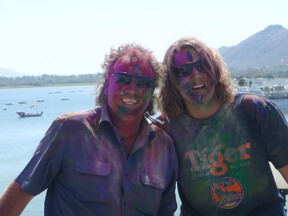

We headed to the RTDC where we had camped before. They took one look at us and said we could use their upstairs showers (provided for the drivers who camp in their cars just like us!) to clean up. We kept close to the hotel doing some PC work and chilling with our books for the rest of the day so we didn't get coloured again. For the next week or so you could see tell tale powder stains on everyone's clothes and hair. Mercifully we got ourselves and our clothes clean with only the odd stain remaining as a memory. Happy Holi everyone!
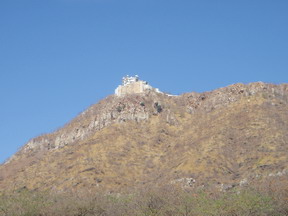
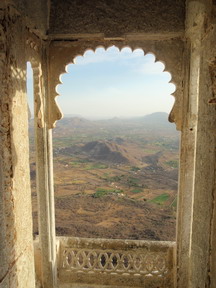
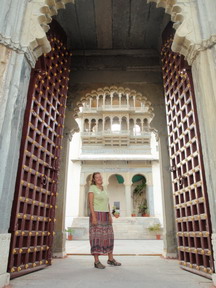
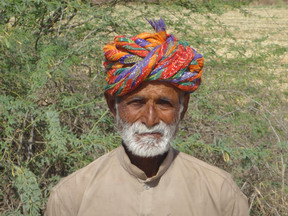
Next day Andrew did some car maintenance and I updated the web - until early evening when we headed again up to the Monsoon Palace to see the sunset. The Monsoon Palace or Sajjan Garh was built in the late 19th century by Maharaja Sajjan Singh.


Once an astronomical centre and later a hunting lodge and monsoon palace it is perched up on a hill top like a real fairy tale castle. It was handed over to the Government in 1956 and it is now pretty dilapidated though a concerted effort to do it up is obviously underway. The views of the sunset over the hills were very lovely and we were glad we'd made the effort to get there.
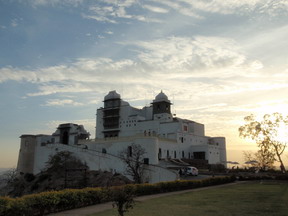
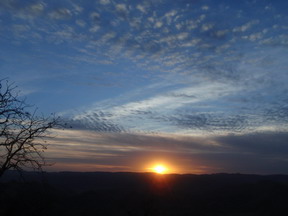
That night we treated ourselves to a nice restaurant - though this time with beer at 260 rupees ($6.50 Aus) a bottle - we just had mineral water! The Ambrai restaurant connected to the Amet Haveli heritage hotel has a superb location an outdoor waterfront garden with sublime views of both the Lake and City Palaces. It was full of up market (mainly French) tour groups when we visited and there were local musicians playing throughout dinner. A great spot and (except for the beer!!) not actually very expensive.
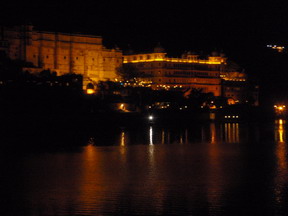

Early next morning with all the Holi revellers no doubt safely out of the way nursing their hang overs we headed on to the historical town of Chittor. Chittor's sole claim to fame is Chittorgarh the town's imposing fort. This 8th century fort is a very special one for Rajasthan people, having a terrible but romantic history much recorded in ballads. Three times when it came under attack from a more powerful enemy giving those inside no hope victory the men women and children chose to die an honorable death rather than face defeat a process called jauhar. Thus the women and children (13,000 on one occasion) threw themselves on a huge funeral pyres whilst the men watched. They (32,000 of them) then donned their saffron robes and rode out to certain death. On the final occasion of jauhar in 1568 (at the hands of the Mughal Emperor Akbar) Maharaja Udai Singh II to preserve the line fled to Udaipur and established his capital there. After this the fort was never re-established and lay empty until it was restored in 1905.
When we arrived we headed to the tourist information which was being boy-ed by a kid who spoke no English. He got the manager on the phone and he told us we'd be welcome to camp in the garden of the tourist information offices. This was kind but we were a bit unsure as the area was a bit grotty and there seemed to be heaps of homeless people around and whilst they were no doubt harmless we thought we might get a fair bit of hassle. We were decided by the young guy who (having obviously not taken in what his boss said) locked the gate and rode off with the keys whilst we weren't looking!! We had heard on the overlanders' grapevine that you could camp within the fort walls but official word seemed to be that it was off limits after sunset and it was now getting late so we took the easy option and headed once more to camp with our old friends the RTDC!
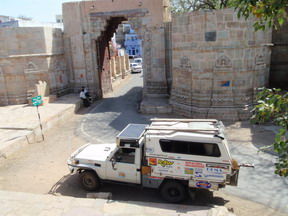
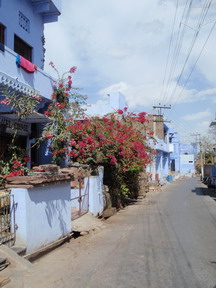
Sadly whilst they had a lovely lawn area at the back this was inaccessible by car so we had to park at the front of the building which was pretty noisy being right on a busy road. We had a good dinner and turned in but unfortunately it was a bit of a disturbed night.

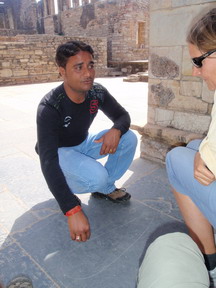
Next morning we headed across the river and up the steep road to explore the fort. Perched on a 180 metre high hill top and taking up 28 sq km the fort is an imposing sight. Apparently it is the world's 3rd largest wall behind only the great Wall of China (which is number one) and nearby Kumbalgarh - which we saw previously. Once the entire town was inside the fort's walls but the new town has now sprawled across the river though some 4,000 people still live in settlements inside the fort.

The ascent to the fort is a zig zaging road passing through the Suraj-Pol or eastern gate which is very beautifully carved with great views over the town and countryside. We got to the ticket office and decided to have a guide with us as the fort is big and sprawling and we thought it'd make it easier to find areas of interest. This was a good decision as Trilok Salvi was a truly great guide. Trilok lives in the small village within the fort and his ancestors once worked for the royal family. He really went out of his way to explain everything to us - if you need a guide he comes recommended and can be contacted on (0) 9314284604.

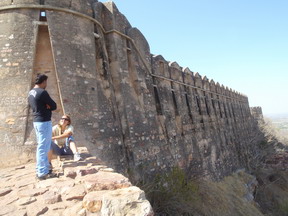
The fort is fairly deserted and not done up for tourists in the way of others we've visited but despite (or because of?) that it is pretty evocative - there are many ruined palaces and over 130 temples. We saw the 15th century Rana Kumbha place - with intricate carving, elephant and horse stables and a Shiva temple.
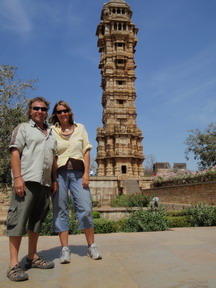

The Jaya Stambha - or Victory tower was a very imposing building. Built in 1458 by Rama Kumbha it commemorates a military victory he notched up in 1440. 37 metres and 9 storeys high it is pretty impressive being finely carved with Hindu deities both inside and outside. You could walk up the 157 steep steps to the 8th floor which is very breezy and affords a great view of the area.
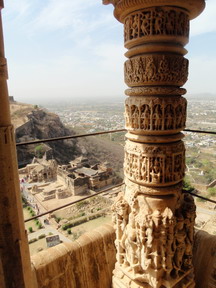
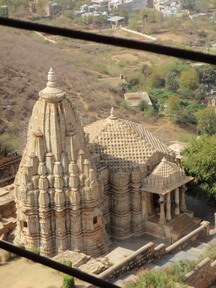
Another impressive building was the Gaumukh Reservoir where you can walk down past temples to a deep tank fed by a spring carved from a cow's mouth. Incredibly in this drought-struck area this spring never ceases to flow so it is considered divine.

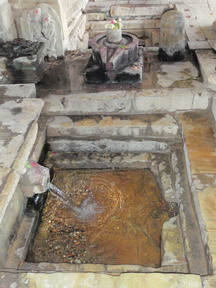
On the way in you can buy pellets to feed the fish in the tank and the resident monkeys. We were a bit hungry and thought the pellets were a snack for us but thankfully we were set straight in time! The tank was a great spot to see a variety of birdlife fishing - we sat and watched 2 Kingfishers -one blue the other white and speckled - for half an hour.
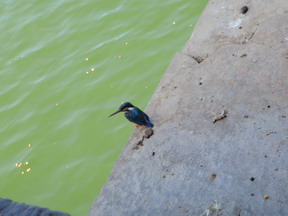

We then saw Padmini's palace which is steeped with legend. I had read that whilst the "death before dishonour" legends are definitely true Padmini's story was invented - but it is still taught to Indian school kids and Trilko was very upset when I suggested that it might not be 100% true! Once upon a time ….in 1303 Chittor was ruled by Rattan Singh whose wife Padmini was incredibly beautiful. Word of her beauty spread to the Sultan of Delhi, Ala-ud-din-Khiliji and he sent word that he wished to see her. Having no choice this was agreed to but in a limited way. The Sultan entered the fort alone & unarmed and viewed her only from a mirror whilst she sat in a pavilion on a lotus pond. After seeing her the Sultan was determined to have her and kidnapped Ratan Singh holding him to ransom. Padmini pretended to agree to marry the Sultan but insisted that her serving ladies accompany her as a wedding party. The Sultan agreed and so 150 veiled carriages - in keeping with the practice of purdah - were sent , but, Trojan horse style these contained soldiers who leapt out once inside and rescued their King. In a fury the Sultan laid siege to the fort - resulting in the fort's first jauhar. The ladies lead by Padmini donned their wedding dresses and jumped in the fire whilst the men rode out to face their end. The pond where the Sultan saw Padmini and the strategically placed mirror are on display. Who knows?!
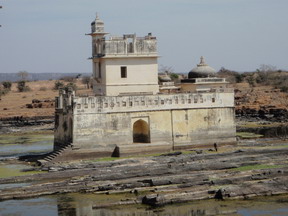
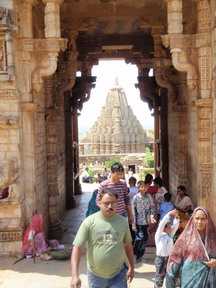
There were numerous other carved temples - a lot honouring the sun god who the royal family traditionally worship. One temple had an interesting depiction of the 3 main Hindu Gods. Brahma (the generator) Vishnu (the operator) and Shiva (the destroyer. ) Very complex Hinduism!!
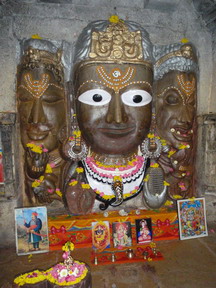

We drove on stopping to look out at the views from the imposing west gate. Finally we saw the 22 metre Tower of Fame - a much smaller version of the Tower of Victory - this tower was constructed in the 12th century by a Jain merchant. It is a monument of the Digambara or Sky Clad sect whose Monks go naked - thus the carvings decorating show various naked figures. There is a similarly ornate temple next to it.


We went for a snack at the RTDC café - the only eatery in the fort though there were a lot of stalls. There is a business here made out of dressing up tourists as a Rajasthan warrior /princess and being pictured and as a prop there are some really lovely horses around - Rajasthan being world renowned for horses. We didn't feel like dressing up though!
Trilok had asked where we were camping and said that we should camp within the fort as all the foreigners (i.e.) overlanders) do. After a noisy night at the RTDC this seemed a good idea so after sundown we came back within the fort. We were just having showers when the security guard came and moved us on. He couldn't speak English so we got Trilok on the phone and he (the security guard) got his boss on his phone and we fought it out!! It seems with the increasing terrorism type issues in the world sadly the life of an overlander is getting harder!!

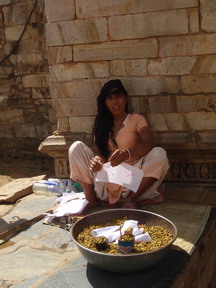
Trilok actually came down to help us and found us a place to camp at a nearby hostel which was mainly used by school parties and archeology students. It was a bit basic so it seemed a bit steep to be charged 200 rupees to park (especially when we later found out the rooms are only 75!!) but we were just glad to turn in. There was a narrow way gateway in with beautiful flowers all around it.


Special thanks go to Trilok for being so helpful and to the security guards at the fort. As we had lost/misplaced our camera memory card the night before we thought that we'd lost all our Chittor pictures and so the guards kindly let us back in the next day for no cost so we could retake our pictures. Thankfully the card turned up in our bed - a mystery how that happened it's usually a tough struggle to get it out - so we ended up with 2 lots of pictures! Thanks guys.

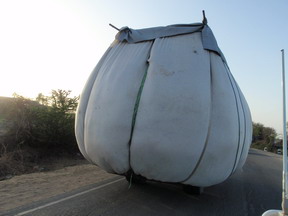
On we drove to our next destination the historical town of Bundi. It is now harvest time and on the road into Bundi we saw numerous crazy loads - trucks quite literally bursting at the seams with chaff to use as animal feed. It was a bit scary sometimes when 2 of these collided as it looked liked they'd push each other off the road. It all adds to the constant ongoing excitement of driving in India!!!


This trip to Rajasthan is a look at those things we missed first time around and the first sight of Bundi made us feel glad we'd made the effort. The old town is a jumble of narrow lanes of Indigo blue dyed houses (originally this colour was confined to the Brahmin Caste but now it's used universally for its cooling and insect repelling properties) with the imposing rock set palace perched above it. We drove first to the Nawal Sagar or lake area (not that there's much water in it now!) where most of the accommodation is but we soon saw there was no way we'd be able to maneuver our car in and out of the narrow lanes, so - as ever - we headed out to the RTDC a couple of kms out of town in a lovely quiet area.
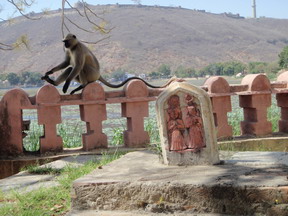
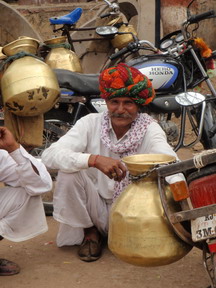
The RTDC was a great place to stay - set on a beautiful water lily covered lake (Jait Sagar) and nice and quiet during our stay (3 nights) we were the only guests on all but one night when a Finnish couple stayed. They have little business we think as comparatively they are a bit pricey compared to the more colourful Havelis which have the advantage of being in town - though they have the disadvantage of being swarmed with tourists and noisy. The team at RTDC (more of them than guests!) were really nice and for the standard 150 rupee camping charge we got to use a room to shower whenever we wanted and watch their TV!! The first night we had dinner there - a non veg thali - which looked pretty veg to us - though it did have an egg a piece which in Indian terms took it into the non-veg category!
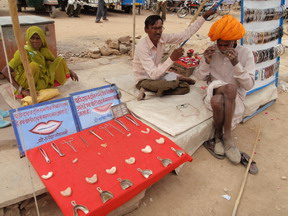
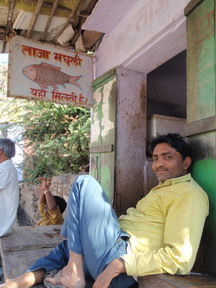
The next day was Saturday morning and we took a wander around the city centre which was very busy and vibrant - stalls selling everything and anything - fish, clothes, brass pots, freshly cooked snacks - you name it! We really liked the dentist cum opticians but although I have had a bit of a sore tooth of late I decided to leave it until we hit Delhi to hunt down a dentist! The area is renowned for big brass pots used for carrying water and/or vegetables and craftsmen hard at work shaping these by hand were all around the market area.
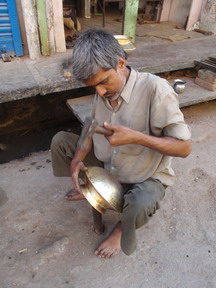
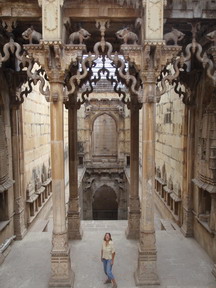
It's funny I must have really become Indian-ized now - nothing shocks me! We met a lovely American lady Connie and spent most of the day with her and a couple of times (especially in the back streets which do a nice line in open sewers!) she was horrified at the mess/smell and whilst I agreed with her I didn't really see it until it was pointed out!! Despite these draw backs Bundi was an atmospheric little town.
Bundi is allegedly also known as the city of baoris or step wells - a good title to have in an area where water is of such importance. We visited one in the centre of town which was particularly impressive. The Raniji-ki-Baori or Queen's step well was built in 1699 by Rani Nathavatji and is the largest well in Bundi being 46 metres deep. It was interesting to see the various marked water levels - now nearly empty the last decent levels were in the early 1990s. The entire well is covered in amazing carvings - mostly depictions of Hindu deities with a particular focus on the god Vishnu in his various (9!) incarnations. We got a guide for this well and he also took us down the road to a nearby tank Bhora-ji-ka-Kund. This was a huge tank now completely dry and in the process of an elaborate restoration which teams of labourers were working on. One lady told us she could remember coming to collect water in the tank when it was half full - which was hard to imagine! Our guide Ramesh was very good and he can be contacted on (0) 9228164266.


In the heat of the day we headed back to Connie's room and took it easy for a while. She was staying at Kasera Heritage View a great spot in a converted haveli which (we were later to find) had a roof top restaurant with a great view of the palace. Her room was massive - more like a suite - pretty good for 500 rupees ($12.50) a night. It was nice to have somewhere to chill out and we sat for a while before having late lunch /early dinner at a nearby rooftop restaurant A & R. This was very nice - but it was a bit disconcerting when we were left on the rooftop and given a large stick to beat off monkeys!! It was nearing dusk and they were gathering in large menacing groups eager to get at any food. We survived the experience - having to bang the stick in warning a couple of times - but it didn't make for the most relaxing dining experience!
As dusk fell we headed on up to the palace - which was now closed - though we got up to the main gate which probably looked better shut with its imposing statues of fighting elephant. Looking at the sky line it was truly amazing (and appalling!) that someone had approved the idea of building an ugly great broadcasting transmission tower right next to the fort!
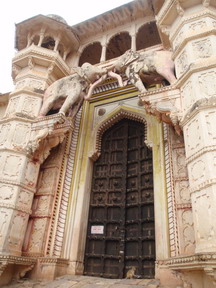

We began the walk up to the 14th century Taragarh or fort which involved walking up a very steep stony path. You could hire sticks to deal with the monkey problem but they were more useful as walking sticks as the path was very steep and uneven. We made it a way and then thought we had taken the wrong path and turned back. We later found out we had been going the right way though it was a bit hard to see and pretty steep. We did mean to go up again the next evening but it never happened as my foot (I have foot issues) was hurting. We got the general idea of the landscape though.
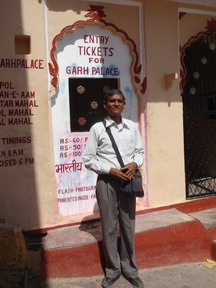
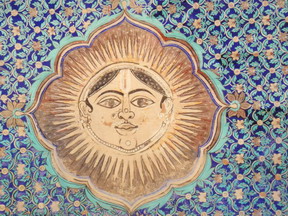
Next day we headed back to the palace and this time made it through the gates! On the way we picked up a guide - Mr. Keshav Bhat an ex-Indian air force officer and full time guide for the last 12 years. He was great value and really thorough in his knowledge - contact him on (0) 9414394241 or via email bharat_bhati@yahoo.com if you need his services. The palace had been shut up for ages but has now been given a bit of a clean and opened to the public. It is full of bats and of an evening you see literally thousands of them filling the sky streaming out of the decaying old buildings like something out of a horror movie.

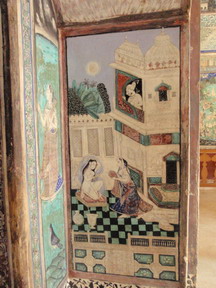
There are a few separate palaces within the complex and they date from the early to mid 17th century. There were numerous very good paintings - many depicting the local Maharajas' main deity the sun god and quite a few of Krishna, but the most impressive were in the Chitrasala. This beautiful garden courtyard with several buildings is more recent having been built by Rao Umed Singh in the 18th century. The inner walls of the buildings are covered in beautiful paintings - mainly in hues of green and blue which Bundi painting is renowned for. There are many of royal life and of the god Krishna some of the best paintings we've seen in Rajasthan which is a big call.
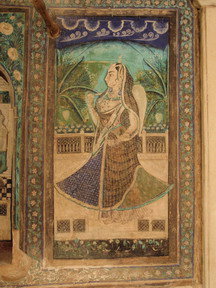
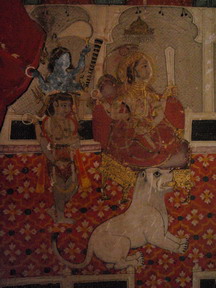
There are numerous little havelis around town and we stopped at one - the Haveli Uma Megh - for lunch. This was beautifully set in a lovely little garden on the lake but we were a bit worried when the menu arrived as it was filthy - not a good look. It wasn't just a bit grey it looked like they'd buried it in the garden and just dug it up …bizarre!! We ordered pizza and it was a actually pretty tasty - but not pizza as we know it. The whole thing was deep fried - a bit like a giant samosa!!! On that note we've really noticed in India - particularly in pure vegetarian Gujarat - how oily a lot of the food is. The Indian preference is for lots of oil which really doesn't agree with us. It's better in more touristy areas where they know more what we like! As I say it was actually quite nice - but you could feel your arteries hardening!
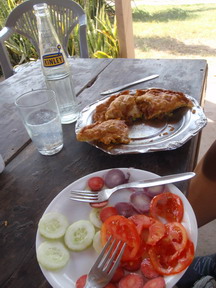
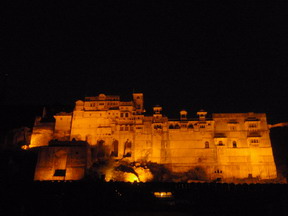
We then spent the rest of the day having a look around various other tourist sites. Out where we were camping was the scenic lake - the Jalit Sagar - which was very pretty though we were sad to just miss seeing it strewn with water lily flowers which will happen in the next month or so. It was very much a working lake as well as a beauty spot as the dhobi wallahs were hard at it thrashing the life out of clothes there!
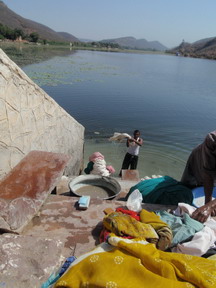

Further on from the RTDC there was a terraced garden which was a really nice place to just sit and relax and watch the bird life and the buffaloes swimming by. Nearby was a small palace the Sukh Mahal - where Rudyard Kipling stayed and wrote his novel "Kim" - whist overlooking the lake allegedly.
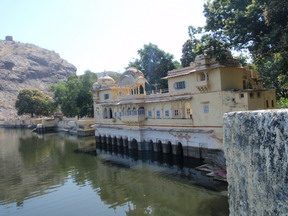
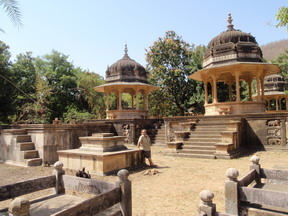
We were lucky to get access to the nearby Sar Bagh a complex with 66 royal cenotaphs some with very beautiful elaborate carving - as we just caught the caretaker locking up. It was a nice shady spot to wander around and the carvings were very impressive.
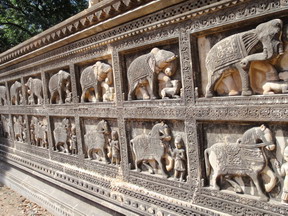
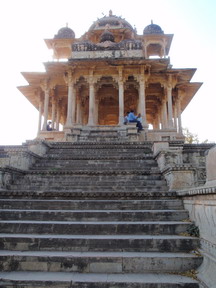
Finally we drove south of the city to the 84 Pillared Cenotaph again showing much beautiful carving this was built to honour the son of the Maharajas' ayah or nanny - reflecting the esteem in which those that served the royal prince were held!

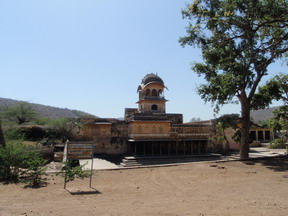
The next day Monday 8th of March we were meant to head off first thing but we'd met some people who'd invited us out to their farm so we went for a bit of a round trip first. Leaving town we stopped first at the Shikar Burj, now fairly derelict this was once a small royal hunting lodge and we were keen to see it as it featured in some of the paintings we'd seen in the palace the day before. There were dozens of resident monkeys who swarmed all over the car - I wished I still had my monkey stick!!
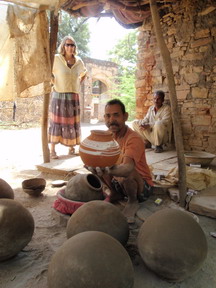
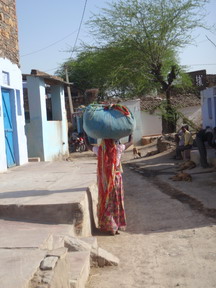
The drive out of town was pretty - through little villages with ladies doing their washing at the pump, local potters at work and colorfully turbaned men herding animals. There is a huge variety of turban styles and colours out here - which tell you a lot about the person's village of origin caste and background - if you knew what to look for - which we didn't - we just admired the colours!

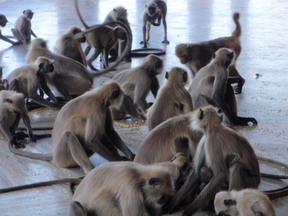
About 20km out of town is the Rameshwar Shiva cave temple and waterfall - though not enough water for that now! It was a steep climb up the steps in the heat to the temple and there were loads of monkeys everywhere. The monkeys are fed at the top - as children of Hanuman a Hindu god they are honoured in this way - which is what makes them such a bloody nuisance- they expect everyone to feed them! A lot of people with offerings got monkeys climbing all over them so we were glad we didn't have any food on us!

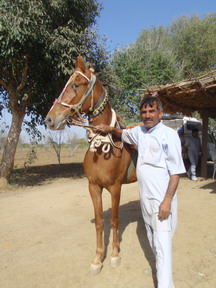
The farm we were visiting was set up by a man from Delhi and had mainly fruit trees. In addition he had set up a cow hospital next door - as cows are sacred there is a lot of merit associated with doing this. Andrew got to star in a turban tying demonstration and one of the neighbours stopped by to show us his horse - stunning horses they have here - which was interesting.
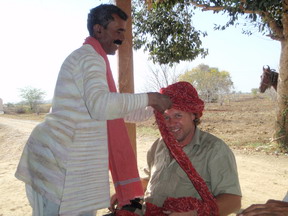

So, it was several hours later than planned when we finally left Bundi and headed for our next destination the non- touristy town of Tonk.
